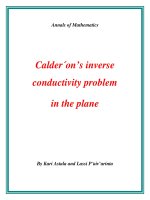Lecture 01 in the twobody problem
Bạn đang xem bản rút gọn của tài liệu. Xem và tải ngay bản đầy đủ của tài liệu tại đây (201.71 KB, 6 trang )
MIT OpenCourseWare
16.346 Astrodynamics
Fall 2008
For information about citing these materials or our Terms of Use, visit: />
Lecture 1
The Two Body Problem
Newton’s Two-Body Equations of Motion
Force = Mass × Acceleration
Gm1 m2 (r2 − r1 )
d r
= m1 21
2
r
r
dt
Gm2 m1 (r1 − r2 )
d2 r2
=
m
2
r2
r
dt2
2
=⇒
1687
d2
(m r + m2 r2 ) = 0
dt2
1 1
G(m1 + m2 ) (r2 − r1 )
d2
−
=
(r − r1 )
r2
r
dt2 2
Conservation of Total Linear Momentum
d2 rcm
=0
dt2
=⇒
rcm = c1 t + c2
Page 96
or
def
where
Two-Body Equation of Relative Motion
µ
d2 r
+ 3r = 0
2
dt
r
#3.1, #3.3
rcm =
m1 r1 + m2 r2
m1 + m2
Page 108
dv
µ
= − 3r
dt
r
r = r2 − r1
r = |r| = |r2 − r1 |
µ = G(m1 + m2 )
where
Vector Notation
• Position Vectors
r1 = x1 ix + y1 iy + z1 iz
r2 = x2 ix + y2 iy + z2 iz
r = r2 − r1 = x ix + y iy + z iz
x1
r1 = y1
z1
x2
r2 = y2
z2
x
r = r 2 − r1 = y
z
• Two-Body Equations of Motion in Rectangular Coordinates
µ
d2 x
+ 3x = 0
2
dt
r
• Velocity Vectors
d2 y
µ
+ 3y = 0
2
dt
r
d2 z
µ
+ 3z = 0
2
dt
r
dx/dt
dr
dx
dy
dz
v=
=
ix +
iy +
i = dy/dt
dt
dt
dt
dt z
dz/dt
• Polar Coordinates
r = r ir
v=
ir = cos θ ix + sin θ iy
iθ = − sin θ ix + cos θ iy =
dr
dr
di dθ
dθ
dr
=
ir + r r
=
ir + r iθ = vr ir + vθ iθ
dt
dt
dθ dt
dt
dt
16.346 Astrodynamics
Lecture 1
dir
dθ
Kepler’s Second Law
1609
Equal Areas Swept Out in Equal Times
Assume z = 0 so that the motion is confined to the x-y plane
d2 x
d �
dy
dx
�
dy
dx
d2 y
0 = x
2 − y 2 =
x
− y
=
⇒
x
− y
= Constant
dt
dt
dt dt
dt
dt
dt
Using polar coordinates
x = r cos θ
y = r sin θ
=⇒
x
dx
d
dθ
dy
−y
= r2
= Constant ≡ h = 2 × Area
dt
dt
dt
dt
Josiah Willard Gibbs (1839–1908)
Vector Analysis for the Engineer
Appendix B–1
Image removed due to
copyright restrictions.
r1 · r2 = x1 x2 + y1 y2 + z1 z2 = r1 r2 cos
�
�
�i
�
� x iy iz �
r1 × r2 = �� x1 y1 z1 �� = r1 r2 sin in
�
x y z �
2
2
2
�
�
�x y z �
1
1�
� 1
r1 × r2 · r3 = �� x2 y2 z2 ��
�
x y z �
3
3
3
(r1 × r2 ) × r3 = (r1 · r3 )r2 − (r2 · r3 )r1
r1 × (r2 × r3 ) = (r1 · r3 )r2 − (r1 · r2 )r3
Kepler’s Second Law
1609
Conservation of Angular Momentum
d
dv
= (r × v) = 0 =⇒
h = r × v = Constant
dt
dt
Motion takes place in a plane and angular momentum is conserved
r×
In polar coordinates
dr
dθ
dr
=v=
ir + r
i = vr i r + vθ i θ
dt
dt
dt θ
so that the angular momentum of m2 with respect to m1 is
r = r ir
m2 r vθ = m2 r2
• Rectilinear Motion:
16.346 Astrodynamics
For r
dθ def
= m2 h = Constant
dt
v, then h = 0 .
Lecture 1
The quantity h is called the angular momentum but is actually the massless angular
momentum. In vector form h = h i z so that h = r×v and is a constant in both magnitude
and direction. This is called Kepler’s second law even though it was really his first major
result. As Kepler expressed it, the radius vector sweeps out equal areas in equal time since
1 dθ
h
dA
= Constant
= r2
=
dt
2 dt
2
Kepler’s Law is a direct consequence of radial acceleration!
Eccentricity Vector
d
dv
µ
µh
µh
dθ
di
(v × h) =
× h = − 3 r × h = − 2 i r × ih = 2 i θ = µ i θ = µ r
dt
dt
r
r
r
dt
dt
Hence
µe = v × h −
µ
r = Constant
r
The vector quantity µe is often referred to as the Laplace Vector.
We will call the vector e the eccentricity vector because its magnitude e is the eccentricity
of the orbit.
Kepler’s First Law
1609
The Equation of Orbit
If we take the scalar product of the Laplace vector and the position vector, we have
µe · r = v × h · r −
Also
µe · r = µre cos f
r=
µ
r · r = r × v · h − µr = h · h − µr = h2 − µr
r
where f is the angle between r and e
p
1 + e cos f
or
r = p − ex
where
so that
def
p =
h2
µ
is the Equation of Orbit in polar coordinates. (Note that r cos f = x .)
The angle f is the true anomaly and p , called the parameter, is the value of the radius
r for f = ± 90 ◦ .
The pericenter ( f = 0) and apocenter ( f = π ) radii are
rp =
p
1+e
and ra =
p
1−e
If 2a is the length of the major axis, then rp + ra = 2a
16.346 Astrodynamics
Lecture 1
=⇒
p = a(1 − e2 )
Kepler’s Third Law
1619
The Harmony of the World
Archimedes was the first to discover that the area of an ellipse is πab where a and b are
the semimajor and semiminor axes of the ellipse.
Since the radius vector sweeps out equal areas in equal times, then the entire area will be
swept out in the time interval called the period P . Therefore, from Kepler’s Second Law
πab
h
= =
P
2
�
√
µp
µa(1 − e2 )
=
2
2
√
Also, from the elementary properties of an ellipse, we have b = a 1 − e2 so that the
Period of the ellipse is
�
P = 2π
a3
µ
Other expressions and terminology are used
Mean Motion
2π
=
n=
P
�
µ
a3
or
µ = n2 a3
or
a3
= Constant
P2
The last of these is known as Kepler’s third law.
• Kepler made the false assumption that µ is the same for all planets.
Units for Numerical Calculations
A convenient choice of units is
Length
Time
Mass
The astronomical unit (Mean distance from Earth to the Sun)
The year (the Earth’s period)
The Sun’s mass (Ignore other masses compared to Sun’s mass)
Then
µ = G(m1 + m2 ) = G(msun + mplanet ) = G(msun ) = G
so that, from Kepler’s Third Law, we have
µ = G = 4π 2
or
k=
where G is the Universal Gravitation Constant.
16.346 Astrodynamics
Lecture 1
√
G = 2π
Josiah Willard Gibbs (1839–1908) was a professor of mathematical physics
at Yale College where he inaugurated the new subject — three dimensional
vector analysis. He had printed for private distribution to his students a small
pamphlet on the “Elements of Vector Analysis” in 1881 and 1884.
Gibbs’ pamphlet became widely known and was finally incorporated in the
book “Vector Analysis” by J. W. Gibbs and E. B. Wilson and published in
1901.
Gibb’s Method of Orbit Determination
Pages 131–133
• Given r1 , r2 , r3 with r1 × r2 · r3 = 0
• To determine the eccentricity vector e and the parameter p
r ×r ·n
r ×r ·n
r2 = αr1 + βr3 with n = r1 × r3 =⇒ α = 2 23
and β = 1 22
n
n
αr − r2 + βr3
p= 1
0 = e · (r2 − αr1 − βr3 ) = p − r2 − α(p − r1 ) − β(p − r3 ) =⇒
α−1+β
• To determine the eccentricity vector, we observe that:
n × e = (r1 × r3 ) × e = (e · r1 )r3 − (e ·
r3 )r1 = (p − r1 )r3 − (p − r3 )r1
Then, since
(n × e) × n = n2 e
e=
it follows that
1
[(p − r1 )r3 × n − (p − r3 )r1 × n]
n2









